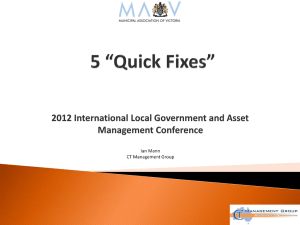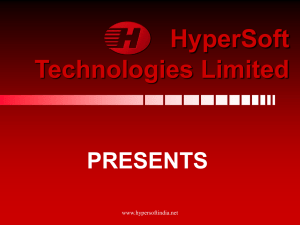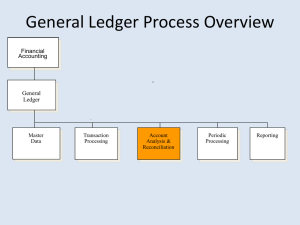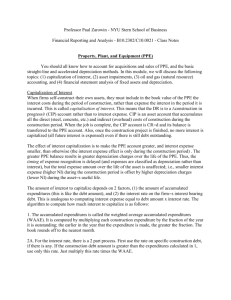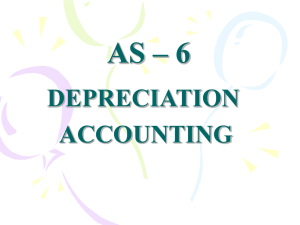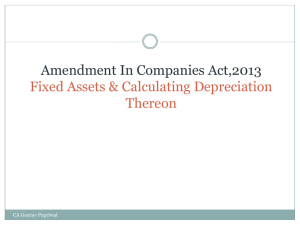Business Cycle of a Fixed Asset - American Public Power Association
advertisement
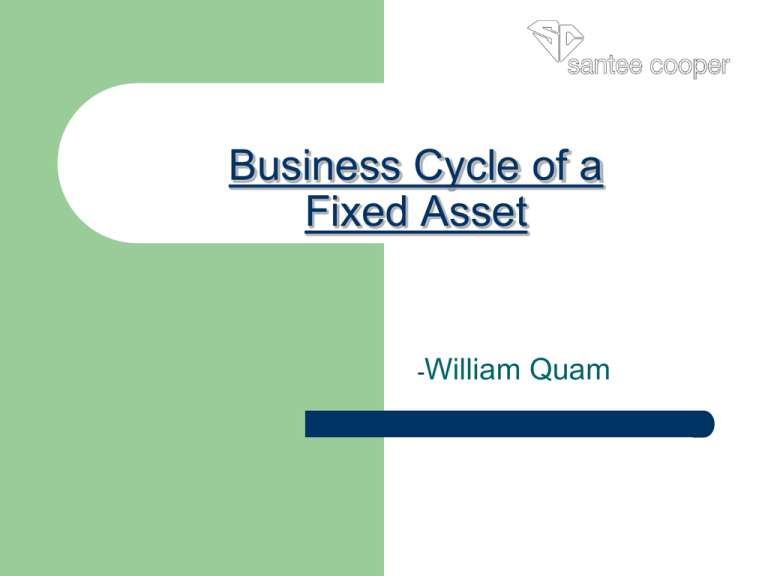
Business Cycle of a Fixed Asset -William Quam Santee Cooper Moncks Corner, SC Santee Cooper Headquarters, One Riverwood Dr. The state's leading resource for improving the quality of life for the people of South Carolina About Us Total Revenue: $1.60 Billion Customers: Retail 162,657 Industrial 31 Wholesale (Co-op) 4 Plant in service: $6.4 Billion 4% 83 % 8% 1% 2008 Generation By Fuel Mix Coal Hydro Oil & LF Gas Nuclear Natural Gas Purchased Power What is a Fixed Asset? Plant, Property, and Equipment For use in operations and not for resale Long-term in nature and usually subject to depreciation Possess physical substance Grainger Generating Station - Steam Capitalization Policy Capitalization policy for capital assets: Guidelines to follow GAAP and Federal accounting regulations for electric utilities provide a guide for the future replacement establish a basis for the amount of insurance coverage required. Capitalization Policy Suggestion #1 from Engineering “At such time that your capital budget has been 100% spent, all future charges shall be classified as operations and maintenance expense” Capitalization Policy Suggestion #2 from Engineering “At such time that your operations and maintenance expense budget has been 100% spent, all future charges shall be classified as capital costs” Capitalization Policy Engineering’s pet names for Accountants: 1) 2) 3) 4) 5) FERC Boy Bean Counter Horse’s Asset Number Geek That Simon Guy from American Idol Capitalization Policy Retirement Unit: Term used to identify items of electric plant The installation of a new addition or complete replacement of a retirement unit is always classified as a capital cost Includes installed cost plus sales tax and overhead Capitalization Policy (cont.) Minor Item: A component part of a retirement unit. When a minor item is replaced independently with a like minor item, the cost is charged to maintenance regardless of $ value. Different rules for addition of minor items which did not previously exist. Capitalization Policy (cont.) Substantial Betterment: Addition of unlike minor items adds years of useful life and/or increased output / efficiency Measurement: Installment cost of unlike minor items exceeds cost of like minor items by at least 35% Retirement Units Major Examples: Building – Warehouse Minor Examples: Ceiling Fans Conveyor System Individual Bucket Transformer Replace & Rewind Inner Coil Dress Pole Policy The first installation of a pole and components shall be charged to construction. The retirement unit will be pole and fixtures. Any additions to pole, charge to O&M Replacement of pole, with or without components, charge to capital Replacement of any components, charge to O&M Software Policy Cost of software is capitalized if: a.) Useful life is 5 years or greater AND b.) Includible costs of development and installation are $200,000 or greater Software Policy (cont.) Includible costs: purchase or development costs, internal or external installation costs, testing, costs to develop software used for data conversion Non-includible Costs: Preliminary investigation costs, manual data conversion, all training after development and installation phases, maintenance contracts Capital Equipment Defined as a retirement unit costing $3,000 or more (including sales tax) and does not require labor or travel to be operational Ex: vehicle, copier, stuffed bear Business Cycle of a Fixed Asset A. B. C. D. E. F. G. Proposal to spend capital dollars Budget Process – 3 yr. / 10 yr. Funding: Cash Improvement Fund or Bond Funded Construction Work in Progress Plant Placed in Service / Depreciation Unitization Retirement / Write-off Proposal to Spend Capital Dollars Originator of Construction Project a) b) Develops proposal for construction project (s) including reason for capital expenditure, drawings and projected cash flows When request proposal is approved by appropriate levels of management, cash flows are added to capital budget. Budget Process 3 year Budget Cycle O&M and Capital Budget Only spend Capital dollars if your capital project is approved as part of your capital budget Board of Directors and Exec. Management approve budget Funding A. B. C. O&M expenses paid by Revenue Fund Capital replacements and improvements paid by Capital Improvement Fund. 8.5% added to every $1 of revenue Large construction projects (generating stations) funded by revenue bonds Budget Variance If Project Manager exceeds the approved capital budget item request amount a) b) c) Director of Plant Accounting can place a hold on additional charges to construction projects in Oracle system Executive Management approval needed to complete construction project that is over budget. Board of Directors approval to increase budget is required on revenue bond funded projects What happens to folks who don’t follow the Accounting Rules The Budget vs. Actual Torture Room HELP!! HELP!! I Ican’t can’texplain explain this thisvariance!! variance!! Construction Work in Progress A. What costs should be included in Electric Plant and CWIP? 1) Code of Federal Regulations Subchapter C, Part 101 Electric Plant Instructions Construction Work in Progress A. What costs should be included in Electric Plant and CWIP? Overhead or Burden Costs Share of management and administrative expenses that indirectly benefit construction Construction’s share of the cost of systems (Inventory, Purchasing) and employee benefits and leave. Construction Work in Progress 2. Overhead or Burden Costs Added per $1 of labor -General A&G -Leave Allocation -Fringe Benefits Added per $1 of Inventory Stock charges -Materials overhead Added per $1 of invoiced charges -Accounts Payable/Purchasing System Construction Work in Progress A. What costs should be included in Electric Plant and CWIP? – – Contribution in Aid of Construction (CIAC) Preliminary Studies – Deferred Debits Construction Work in Progress B. Tracking Capital Costs 1.) By Budget Item Code (ex: G00048=Cross Unit 4) 2.) By Project Number (ex: 107796=Cross Unit 4 Construction) 3.) By Asset Category Code (ex: ES.3120.B130=Boiler) 4.) By Asset Location Code (ex: SC.BERK.SC401=Cross Complex Unit 4) Plant Placed In Service A. When are assets considered in-service? 1) When management declares start of commercial operations – (ex: generating unit) 2) When energization takes place – (ex: lines & substations) 3) When purchased and delivered – (ex: capital equipment) 4) When Santee Cooper begins using item Plant Placed In-Service B. Accounting Treatment 1) In the month that asset is placed in service: Asset cost transferred from CWIP-1070 to Utility Plant in service-1060 Depreciation of asset begins Plant Placed In-Service C. Internal controls – – 1. All capital projects must declare estimated inservice date before approval. Estimated date entered in Oracle System 2. Oracle system prompt to Plant Accounting & Project Mgr. if assets not in-service by estimated date. Depreciation A. Methods Used 1) Composite Method Used for most of Santee Cooper’s assets Depreciation rate applied to groups of assets that are not similar (e.g.: steam generation, transmission substations) Study of depreciation rates required every 5 – 7 years No gain or loss on retirement Depreciation A. Methods Used 2) Composite Rates One depreciation rate for each production category (ex: steam, hydro, nuclear, other power) Individual depreciation rate for each FERC regulatory acct. (Transmission, distribution, generation plant) Depreciation A. Methods Used 3) Straight Line or Amortization Limited use on intangible and some general plant assets Assets are homogenous. (ex: computer equipment) Recognize gain or loss on retirement Unitization A. B. Process of placing assets into proper FERC Uniform System of Accounts Last chance to catch errors Retirements / Write-offs A. B. C. Accounting treatment for retirements Accounting treatment for write-offs GASB 42 – Impairment of Capital Assets

